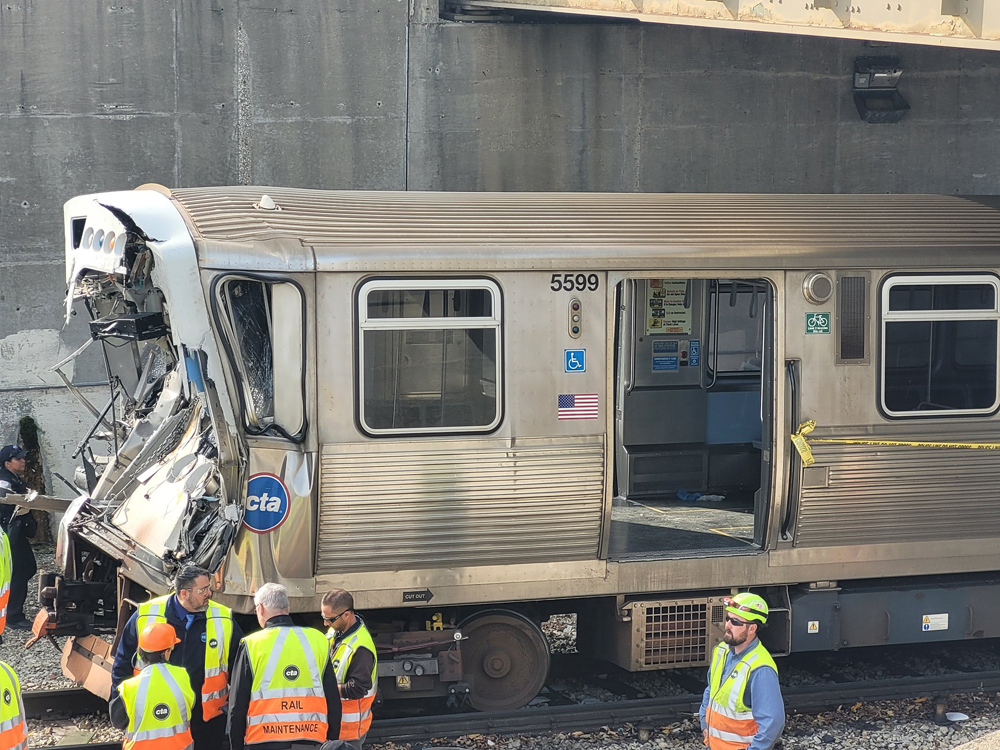
WASHINGTON — A Chicago Transit Authority train was in an emergency brake application when it struck a snow removal machine last month, according to the preliminary report released today (Tuesday, Dec. 12) by the National Transportation Safety Board.
While preliminary reports set basic facts of an accident and do not determine cause of an incident, the Associated Press reports that NTSB Chair Jennifer Homendy said during a Tuesday press brief that, “All the data we’ve received and all the testing we’ve conducted indicates to us that the operator did not do anything wrong.”
The collision occurred Nov. 16, 2023, at about 10:30 a.m. near the Howard station on the city’s North Side. It involved a Yellow Line train on its way from the Dempster station in Skokie, Ill., to Howard, and a snow removal machine being used for training purposes; 16 people were taken to hospitals with injuries [see “Chicago L train hits maintenance equipment …,” Trains News Wire, Nov. 16, 2023]. The Yellow Line train was traveling 54 mph when it received a stop signal because of the snow removal machine about 2,150 feet ahead, and began braking immediately, with the operator initiating emergency braking upon seeing the snow removal equipment for the first time. The train had slowed to about 27 mph at the time of the collision.
The preliminary report indicates the ongoing investigation will focus on design and configuration of the CTA’s signal system, design and braking performance of the railcars involved in the accident, and examination of organic material on the rails to determine if that material had any impact on the accident.
In a press briefing in Chicago shortly after the accident, Homendy said “a design problem” with the brakes played a part in the accident, explaining that the CTA braking algorithm called for the train to be able to stop in roughly 1,000 feet less than would be the current standard [see “NTSB chair says design problem with brakes is factor …,” News Wire, Nov. 18, 2023]. She again touched on that issue in Tuesday’s briefing, the AP reports, saying stopping distance and the CTA’s signal configuration is “something we will be looking at further.”
Service on the Yellow Line remains suspended almost a month after the collision. WBBM-TV reports Homendy said the NTSB returned control of the accident site to the CTA four days after the accident and restoring service is wholly up to the transit agency. “We’re still conducting or investigation,” she said, “so it’s up to CTA to ensure the safety of their system.”
The CTA has reduced speeds on the Yellow Line from 55 mph to 35, Homendy said, and to 25 mph at the exact site of the accident. It has also increased cleaning of the rails and will have supervisors accompany Yellow Line operators when the line reopens.














The article also implies leaves or residues on rails could have made for slick conditions lengthening normal stopping distances.
If “All the data we’ve received and all the testing we’ve conducted indicates to us that the operator did not do anything wrong.” then why will supervisors accompany Yellow Line operators when the line reopens?
I am wondering why still no service on this line after the NTSB left after 4 days. They must going through the area rock by rock. It is 4 days shy of a month since the accident.
They still haven’t touched on the subject of why the plow and train were on the same track at the same time.
Sounds to me like it could have been a signal issue. The CTA train operator should have seen an approach signal prior to the stop signal. The fact that he was going 54 mph when instead he should have been slowing prepared to stop at the restricted signal leads me to this conclusion.